Matador Network's Blog, page 508
March 24, 2022
Bookend Your SoCal Trip at These Top San Diego Airport Hotels

San Diego International Airport (SAN) is just north of downtown, easily accessible from all points of the city. Due to its proximity to popular attractions like the San Diego Zoo and beach towns like Mission Beach and Ocean Beach, it’s feasible to spend an entire trip at a hotel near the San Diego Airport without missing a beat of the city. It’s also super easy to bookend a trip at one of the below hotels, making your flight schedule a breeze.
We hope you love the San Diego airport hotels we recommend! Just so you know, Matador may collect a small commission from the links on this page if you decide to book a stay. Listed prices are accurate as of the time of publication. See our full Advertiser Disclosure here.
Headliner San Diego airport hotelsTop Hilton Honors hotels near San Diego AirportTop Marriott Bonvoy hotels near San Diego AirportTop IHG Rewards hotels near San Diego AirportTop Wyndham Rewards hotels near San Diego AirportHeadliner San Diego airport hotelsHampton Inn San Diego Airport and Liberty Station
Photo: Booking.com

Photo: Booking.com

Photo: Booking.com

Photo: Booking.com
The closest hotel to San Diego International Airport is the Hampton Inn. Located just over the water from Liberty Station NTC Park, a stay here puts you in prime position to avoid a long check-in line for that morning flight (or an expensive Uber ride upon a late arrival). Onsite, swim a few laps in the outdoor pool, have a drink on the terrace, or simply relax in your well-trimmed room. With a convenient shuttle, nice fitness center, and — despite its proximity to the terminal –quick city center access, you can’t go wrong here, making it Matador’s top pick for a quick one-night stay or bookend.
Airport shuttle: yes
24-hour front desk: yes
Fitness center: yes
Price: From $176 per night
Top Hilton Honors hotels near San Diego AirportHilton San Diego Airport/Harbor Island
Photo: Booking.com

Photo: Booking.com

Photo: Booking.com

Photo: Booking.com
Just five minutes from the airport, the Hilton San Diego Airport/Harbor Island is the nicest hotel in the airport vicinity. Sailboat and bike rentals are available onsite, with easy water access at the marina just a couple of minutes’ walk. Inside the hotel, crash out on the brand’s trademark Serenity Suite Dreams mattresses and be sure to spend some time poolside soaking in the Southern California sun. Balconies overlook the water, making for one of the most iconic places in San Diego to watch the sunset. The hotel has a top-tier restaurant, the Panorama Bar & Grill, onsite, with room service available for late and early flights.
Airport shuttle: yes
24-hour front desk: yes
Fitness center: yes
Price: From $158 per night
Homewood Suites by Hilton San Diego Airport
Photo: Booking.com

Photo: Booking.com

Photo: Booking.com
Each suite at Homewood Suites by Hilton San Diego Airport has plenty of lounge space, a work desk, and at least a queen-size bed. Two-bedroom suites are available if you have the family in tow. Located right on the North San Diego Bay, take a stroll along the waterfront or relax over a drink on the hotel’s outdoor terrace. This is the spot for business travel, as it offers room to breathe and easy access to downtown.
Airport shuttle: yes
24-hour front desk: yes
Fitness center: yes
Price: From $193 per night
Top Marriott Bonvoy hotels near San Diego AirportTownePlace Suites by Marriott San Diego Airport/Liberty Station
Traveling to San Diego? Check out Matador’s guides to the best places to stay in Southern California:
These beautiful San Diego Airbnbs put you close to the beach and downtown 9 dreamy oceanfront Airbnbs up and down the California coast 10 soulful beach Airbnbs for the perfect SoCal yoga retreat 12 very zen Joshua Tree Airbnbs perfect for families and groups

Photo: Booking.com

Photo: Booking.com

Photo: Booking.com
There’s a reason why all-suite hotels hold such a strong place in airport hotel villages. They’re designed for the frequent traveler, the family traveler, and any who want guaranteed comfort before or after a hectic day. TownePlace Suites by Marriott San Diego Airport/Liberty Station epitomizes this for SAN. Each room boasts an apartment-esque vibe, without the need to cook — the hotel’s breakfast buffet is worth a stay in itself. With gorgeous views out over the bay and easy access to the entire central city, this is a sure-bet for a relaxing stay.
Airport shuttle: yes
24-hour front desk: yes
Fitness center: yes
Price: From $188 per night
Courtyard San Diego Airport/Liberty Station
Photo: Booking.com

Photo: Booking.com

Photo: Booking.com
Dine or swim right on the water, before tucking into a high-thread-count night of comfort — the Courtyard San Diego Airport/Liberty Station is not the standard, boring airport hotel you’re accustomed to. With outdoor dining and events, a massive fitness center, and easy access to long waterside strolls, this is the place to stay if you only have one night in San Diego — or if you want to make each night an experience in itself. Grab lunch from the waterside deli if you have a chance — it’s the easiest way to feel as though you’re at a far-flung beach resort (and take your mind off that upcoming flight).
Airport shuttle: yes
24-hour front desk: yes
Fitness center: yes
Price: From $185 per night
Top IHG Rewards San Diego airport hotelsHoliday Inn Express Hotel & Suites San Diego Airport
Photo: Booking.com

Photo: Booking.com

Photo: Booking.com

Photo: Booking.com
Holiday Inn Express is what happens when a chain hotel reinvents itself and succeeds. Rooms are bright and clean, the front desk runs all night, and you’re just a few miles from Old Town in one direction and the beach in the other. As far as continental breakfasts go, this is a good one — with fresh omelets and one-minute pancakes headlining the show. If flying out of SAN because you live between here and LA, or otherwise are venturing to the city to fly out, this is the spot for you.
Airport shuttle: yes
24-hour front desk: yes
Fitness center: yes
Price: From $144 per night
Top Wyndham Rewards San Diego airport hotelsRamada by Wyndham SeaWorld/Mission Beach
Photo: Booking.com

Photo: Booking.com
A staple near airports nationwide, Ramada by Wyndham San Diego Airport offers mid-level comfort and a quiet night’s sleep. This one offers the benefit of also being near two of the city’s top attractions. If in San Diego for a weekend and looking to do the highlights without stressing about your flight home, this is the place to stay. Be sure to check out Ocean Beach while you’re here. 
Airport shuttle: yes
24-hour front desk: yes
Fitness center: yes
Price: From $97 per night
More like thisWhere to StayBookend Your Trip To Los Angeles at These Inspiring Hotels Near LAXBest Airbnbs in Puerto Rico From City Houses To Coastal Villas

It’s only 100 miles long and 35 miles wide, but Puerto Rico has a lot to love. The Caribbean archipelago is a haven for beach lovers, a playground for adventure seekers and a place where foodies rejoice. Start in San Juan, where the beach is always close, or get off the grid in the mountains of Cayey. In Vieques, famous for its bioluminescent bay, there’s an 80’s cliffside villa. And a stay in Rincón’s surfer’s paradise means rooftop sunsets and breezy beachside condos. If you’re looking for the best Airbnb in Puerto Rico, here’s our selection that will guarantee an unforgettable stay.
We hope you love the Airbnb Puerto Rico rentals we recommend! Just so you know, Matador may collect a small commission from the links on this page if you decide to book a stay. Listed prices are accurate as of the time of publication. See our full Advertiser Disclosure here.
The best Airbnb rentals in San Juan, Puerto RicoThe best Airbnb rentals in Rincón, Puerto RicoThe best Airbnb rentals in Vieques, Puerto RicoThe best Airbnb rental in Cayey, Puerto RicoThe best Airbnb rentals in Luquillo, Puerto RicoThe best Airbnb rental in Monte Carmelo, Puerto RicoThe best Airbnb rentals in San Juan, Puerto Rico
There’s more to Puerto Rico’s capital city than meets the eye. Beaches, street art, salsa dancing in the streets, and some of the island’s most important historic forts call San Juan home.
1. Spacious house on the beachfront

Photo: Airbnb
Condado is one of San Juan’s most popular neighborhoods. The shoreline is packed with exciting restaurants and nightlife, and this bright condo is in the heart of it all.

Photo: Airbnb
Here you’ll wake up to floor-to-ceiling window views of the beach in a breezy, ocean-inspired setting. Spacious enough for six guests, Rob and Kat’s place is excellent for medium-sized groups looking for somewhere convenient and comfortable to stay in the capital city.
Six guests, two bedrooms
Price: $350 per night
2. Serene apartment with lush greenery in San Juan

Photo: Airbnb
Escape the hustle of San Juan at this peaceful paradise apartment. While the living space is artfully-designed and airy, the star here is the outdoor patio.

Photo: Airbnb
Soak up the sun on the shaded terrace surrounded by palms, and don’t leave before indulging in the green-tiled outdoor shower. Maria’s place feels like a place of refuge in the Ocean Park Beach Neighborhood–steps away from Lozia Street, where local bites and street art live.
Four guests, two bedrooms
Price: $211 per night
3. Charming Spanish house in Old San Juan

Photo: Airbnb
Terracotta tiles, a plant-filled atrium, and a Spanish-inspired spiral staircase make this charming home an excellent option for mid-sized groups looking for an Airbnb San Juan masterpiece.

Photo: Airbnb
Just outside your doors is the heart of Old San Juan. Cobblestone streets lead to cultural must-sees like the historic fort, Castillo San Felipe del Morro, and Cuban-inspired speakeasy, La Factoria.
Eight guests, four bedrooms
Price: $291 per night
4. Bright artist abode five minutes from the beach in San Juan

Photo: Airbnb
Wake up feeling inspired in this art-filled Airbnb in Puerto Rico. It’s airy, full of natural light, and the walls are adorned with plants and local artists’ artwork. As far as Airbnb San Juan rentals, this is the brightest — and among the most convenient.

Photo: Airbnb
The three-bedroom space is ideal for mid-sized groups looking for an intimate stay that allows room to spread out with a living area, dining table, open kitchen, and balcony. Step foot outside into the Ocean Park neighborhood of Puerto Rico’s capital city, and you’ll find spots to windsurf or paddleboard, the Museum of Contemporary Art, or the street murals of Santurce.
Eight guests, three bedrooms
Price: $313 per night
The best Airbnb rentals in Rincón, Puerto Rico
A trip here means eight miles of coastline where the Caribbean sea meets the Atlantic. Rincón is a lowkey town of leisure best suited for surfers and nature lovers in need of relaxation.
5. A tropical suite and private pool close to Rincón’s best snorkeling

Photo: Airbnb
Here you can leave your worries at the villa door. Tropical Suites in Rincón have everything you need to relax with the one you love: a king-sized bed, private swimming pool, a large stand-alone tub, and a rooftop terrace.

Photo: Airbnb
If you ever decide to leave the comfort of your suite, the best beaches in town are just three minutes away, along with Rincón’s lighthouse, Faro de Punta Higüera, and a host of restaurants and bars.
Two guests, one bedroom
Price: $168 per night
6. A bohemian style suite with pool and an open-air tub

Photo: Airbnb
Step into bohemian bliss at this one-bedroom suite in the mountains of Rincón. The villa has an airy feel with plenty of natural wood decor and an outdoor, poolside tub–the best of both worlds.

Photo: Airbnb
The living area is intimate with an entertainment center and a cozy open concept kitchen. If you’re looking for somewhere to get away to rest, this is the place for you.
Two guests, one bedroom
Price: $297 per night
7. Mediterranean-style home ten minutes from the center of Rincón

Photo: Airbnb
This Mediterranean-inspired villa is an Airbnb in Puerto Rico you won’t forget in a hurry. It sits right on the ocean in the sleepy Barrero neighborhood.

Photo: Airbnb
There’s a lot to love with private beachfront access, two pools, a relaxing gazebo, and cozy hammocks. Wood interiors with pops of colors and floor-to-ceiling windows make this place a breezy stay. And it’s ideal for large groups with six bedrooms and five bathrooms — there’s a whole lot of space for a quiet getaway just two minutes away from restaurants and bars and ten minutes from the center of town.
Fourteen guests, six bedrooms
Price: $1,650 per night
8. Beachfront condo steps away from the best surfing in Rincón

Photo: Airbnb
Ricon, where the Caribbean sea meets the Atlantic, has some of the best sunsets in Puerto Rico. And with this beachfront condo situated just steps away from Corcega beach, you’ll have one of the best views in town.

Photo: Airbnb
Adianice’s place promises to give an authentic experience in Rincon with airy interiors, cool ocean-like tones, and a pool right on the beach. Though the condo is in a quaint, private neighborhood, it’s just minutes away from Rincon’s best beaches for water sports like surfing, paddleboarding, and snorkeling.
Four guests, one bedroom
Price: $170 per night
The best Airbnb rentals in Vieques, Puerto Rico
Located just a 25-minute plane ride from San Juan on the eastern Caribbean coast, Vieques is worth catching a flight. The island’s highlight is Mosquito Bay — a bioluminescent bay where microorganisms beautifully tint the water in a blue-green glow.
9. Peaceful treehouse on a lush farm with pool

Photo: Airbnb
The 25-minute plane ride from San Juan to the bayside island of Vieques will be more than worth the journey. Tucked away behind miles of wooded land is this peaceful treehouse on a lush farm.

Photo: Airbnb
It’s a dreamy place to be made with natural wood finishes, surrounded by vegetation, and not-too-distant views of the ocean. In between visits to Vieques’ famous bioluminescent bay (you can’t skip this) and black sand beach, cozying up in the treehouse’s hammocks will make it hard to leave. Other top features include a saltwater pool, an all-vegan menu, and an ayurvedic-driven spa.
Two guests, one bedroom
Price: $162 per night
10. Oceanfront villa with cliffside pool
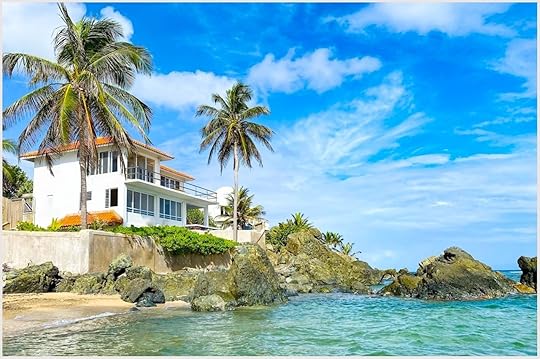
Photo: Airbnb
Only a few feet stand between this oceanfront villa and the sand of La Chata Beach on Vieques. Conveniently located just minutes from the center of town but still tucked away for a luxurious secluded feel, ‘Las Piedras’ is one of the best Airbnbs in Puerto Rico.

Photo: Airbnb
It’s a well-designed villa built in the ’80s by a prominent magazine publisher as a place of refuge from city life. The property was recently renovated and has multiple decks, a cliffside pool, and direct, private beach access. La Chata beach is a bit of a local’s secret — it’s a hotspot for snorkeling, whale watching, and a nesting site for sea turtles.
Eight guests, five bedrooms
Price: $850 per night
The best Airbnb rental in Cayey, Puerto Rico
Tucked away in Purto Rico’s central mountain region, Cayey is full of scenic landscapes and gastronomy worth road-tripping for.
11. Luxury villa in the heart of Cayey’s mountains

Photo: Airbnb
This luxurious, hillside villa is tucked away in peace in the mountain town of Cayey. Perfect for a medium-sized group, Casamerica is a villa with the home-like feeling of a cabin.

Photo: Airbnb
The interiors are designed with earthy tones — from deep brown woods to lush greens. When this host said luxury, they meant it. There are two decks: wine and brunch, a koi fish pond, an infinity pool, and jacuzzis with a mountain view in the master bedroom. If you’re planning for a retreat or staycation, this is one of the best Airbnbs in Puerto Rico.
Eight guests, four bedrooms
Price: $1,200 per night
The best Airbnb rentals in Luquillo, Puerto Rico
Home to the incredible El Yunque National Forest, Luquillo can’t be missed. Known as la Capital del Sol (“the Sun’s Capital”), it’s a beach lovers paradise.
12. Tropical villa surrounded by the rainforest in Luquillo

Photo: Airbnb
Worship the sun in Luquillo — located just thirty minutes away from San Juan’s airport — at this tropical hideout. Surrounded by the rainforest, the estate is one of the best Airbnbs in Puerto Rico for large groups.

Photo: Airbnb
The 4,000 square feet of space includes a private pool, ample garden space, and even a small soccer field. When you’re not luxuriating villa side, Luquillo has more than 12 miles of coastline and calls El Yunque National Forest its neighbor. Spend a day hiking the forest and jumping in swimming holes, and by night, dine al fresco at Los Kioskos de Luquillo, a roadside strip of bars and restaurants.
Sixteen guests, six bedrooms
Price: $644 per night
13. Romantic hideaway with panoramic coastal views

Photo: Airbnb
Located along an untouched strip of La Pared surf beach, this romantic home is just a short walk from top restaurants like BLANK — the perfect date night spot.

Photo: Airbnb
Rest well knowing that the one-bedroom condo is quiet, features modern appliances and decor, and has a large balcony for all the sunset watching opportunities Luquillo offers.
Two guests, one bedroom
Price: $160 per night
The best Airbnb rental in Monte Carmelo, Puerto Rico
Monte Carmelo is a peaceful neighborhood tucked away in the heart of Vieques. Surrounded by mountains and tuckered behind trees, it’s the perfect place to get off the grid for a little bit.
14. Oceanside villa with rooftop deck for stargazing

Photo: Airbnb
Spend your days poolside and your nights stargazing from the roof deck of this private hilltop villa. Modernly designed for relaxation and luxury, hammocks hug the villa’s palm-lined terrace, and an outdoor shower stands just beyond the saltwater pool.

Photo: Airbnb
There are two bedrooms available — the master bedroom features a queen bed with french double doors that open up to a private deck overlooking the ocean. The second bedroom has two cozy single beds making this villa perfect for small families. If you ever decide to leave this haven, the nature of Vieuqs awaits you with easy-to-love beaches like Playa Esperanza. 
Four guests, two bedrooms
Price: $360 per night
March 23, 2022
Certain People Can Now Use Their iPhone To Get Through Airport Security. Here’s Who Qualifies.

Back in September 2021, the TSA and Apple announced that they were working on a way for travelers to use their iPhone to get through airport security. The time has finally come for Arizona residents passing through Phoenix, with more locations on the way.
As of March 23, 2022, people with an Arizona ID can upload a digital version to their Apple Wallet and use it as identity verification at Phoenix Sky Harbor International Airport.
“Today’s announcement marks a significant milestone in TSA’s efforts to improve airport security screening,” TSA administrator David Pekoske said in a statement. “As mobile device technologies continue to advance and become more secure, TSA is committed to leveraging those technologies wherever possible to enhance airport security, reduce touchpoints, provide greater privacy protections to individuals, and facilitate greater accuracy in identity verification capabilities at TSA checkpoints.”
Phoenix is the first of “many airports this year” that will allow the feature, Pekoske noted.
Before waltzing off to the airport without double checking that you have your ID, there are a few things to consider. First, it’s only available at this time for Arizona residents going through PHX who have their ID uploaded on their iPhone or Apple Watch. Second, it’s only available to TSA PreCheck passengers — which might just be the extra boost you’ve been waiting for if you’ve been on the fence about committing to PreCheck, Clear, or any of the other ways to bypass the line. The capability for those without PreCheck will come “soon,” according to the press release.
The third thing to keep in mind is the real kicker: The TSA states that all travelers, even those who meet the first two requirements, “must continue to carry and have readily available their physical driver’s license or identification card, or other acceptable ID listed on the TSA website.” And yes, they may need to check said physical ID before letting you pass — though you’ll need it for your return trip regardless, of course.
Yet just like with physical boarding passes, it’s still more convenient to have it all on your phone (so long as you have a good portable charger of course).
To use a digital ID, passengers tap their iPhone or Apple Watch to the TSA’s credentials reader. Then the TSA agent verifies the information and you’re all set to go past security to the incredible dining options that Phoenix Sky Harbor has to offer.
People outside of Arizona might not have to wait long. Apple listed additional states to join Wallet ID, and thus TSA passing capabilities, include Georgia, Connecticut, Kentucky, Iowa, Maryland, Oklahoma, and Utah, along with Colorado, Hawaii, Mississippi, and Ohio.
Fly To Madeira and Spend Six Nights in a Baller Hotel for Just $699

When to travel: March 2022 through April 2022
From: JFK Airport direct to Madeira
Fully refundable: Yes
The season of travel is fast approaching. There’s nothing quite like Europe during summer — and this is more true than ever when you’re headed overseas at an unbeatable rate. Starting at just $699, this Travelzoo deal flies you from New York City direct to Madeira and includes six nights in a four-star hotel .
Madiera is truly off the beaten path, a sunny and charming Portuguese Archipelago rich in outdoor adventure, eco-friendly wildlife sightseeing, and some of the best cuisine on the planet. Elected “World’s Leading Island Destination” from 2015 to 2021 by the World Travel Awards, take in the wonders and enjoy the mild weather of this unique destination. Travelzoo’s deal features an exclusive nonstop flight plus 6 nights in a 4-star hotel starting at just $699 per person.
These last-minute packages are only on sale for a limited time, so act now to make 2022 the most epic Euro-summer you’ll ever experience.
African American museum in DC

Time spent inside the National Museum of African American History and Culture (NMAAHC) in Washington, DC, hangs heavy on the soul. This is one of the many reasons it’s among the most vital museums in the entire Smithsonian museum complex.
NMAAHC honors the complexity of Blackness in North America and cherishes the achievements of African Americans who built the nation with their bare hands. To borrow a phrase from one of the museum’s galleries, African Americans have been “making a way out of no way” for generations. NMAAHC chronicles the triumphs and tribulations that have defined these generations, from the history of enslaved Africans to America’s civil rights movements and Black Lives Matter, shedding a light on the country’s thriving Black culture in spite of racial oppression.
Museum curators tell us there’s no right way to see NMAAHC’s 12 exhibitions, almost 37,000 objects, and 183 videos, but they do warn that it’s difficult to accomplish in a single visit. Since museumgoers are unlikely to be able to dedicate an entire three-day weekend to exploring the museum, we visited NMAAHC multiple times to create this guide to navigating 600 years of dense, important history in one day.
Before you go: the #1 piece of advice for visiting the museumTickets, opening hours, and the best times to visitWhere to startMust-see displays and why they matterThe gallery you shouldn’t skipUnderrated exhibitions to check outBefore your leaveBefore you go: the #1 piece of advice for visiting the National Museum of African American History and CultureWhen visiting NMAAHC, mental preparedness is as important as logistical planning. There’s a lot to take in — emotionally and physically given the museum’s 350,000 square feet — and visitors are encouraged to reflect on their own place in history as they tour.
Words like “powerful,” “emotional,” “sad,” and “angry” have all been used to describe the NMAAHC experience. The museum makes space for these reactions and provides visitors with designated “reflections” spaces. Use them. Tempting as it might be to breeze through with one eye on the exhibits and one eye on your smartphone, you’ll get the most out of your visit if you pay the museum the respect it deserves, come with open mind, and leave prepared to chew on everything you learned.
Opening hours, admissions, and the best times to visit the National Museum of African American History and CultureAlthough the museum opened in 2016, it remains a compelling attraction, so be prepared for large crowds all year. To enter the museum, all visitors must have timed-entry passes, which can be reserved online up to 30 days before your visit. Same-day passes are also available online starting at 8:15 AM EST, but only a small amount are issued each day, so advance reservations are highly recommended. Like all Smithsonian museums, entry passes are free.
The National Museum of African American History and Culture’s opening hours are from 10:00 AM to 5:30 PM, seven days a week except December 25. (Note that 4:00 PM is the latest you can enter the museum, and exhibitions start closing at 5:15 PM.) The busiest hours are noon to 4:00 PM from Fridays to Sundays, particularly between March and August, and on holidays. If you plan on visiting the museum on a weekend, holiday, or during peak season, come in the morning to avoid long wait times.
Grab a museum map from the information desk when you enter. For more in-depth guidance, download the museum’s mobile app — free WiFi is available on all levels.
Where to start your visit to the National Museum of African American History and Culture
Photo: BrianPIrwin/Shutterstock
It may sound silly, but the best place to start your tour is outside. Adjacent to the Washington Monument, the 400,000-square-foot bronze-hued building that houses the museum is as much a part of the experience as any exhibit. Even its position on the National Mall is emblematic given that The Mall is a platform for America’s democratic values of liberty, equality, and justice.
Award-winning architect David Adjaye designed the three-tiered museum in the image of a Yoruban Caryatid, a type of traditional wooden statue from West Africa that’s shaped like a column and topped with a crown. The patterns on the aluminum panels portray the 19th-century ironwork of enslaved craftsmen in New Orleans. They allow daylight to shine through and, at night, light up the crown from within. The perimeter of the grand porch on the south entrance by the National Mall is also significant, having been symbolically bedded with live oaks. For enslaved peoples, live oaks represented safety, strength, and resilience as they provided shade and shelter and served as gathering spots for meetings and religious services.
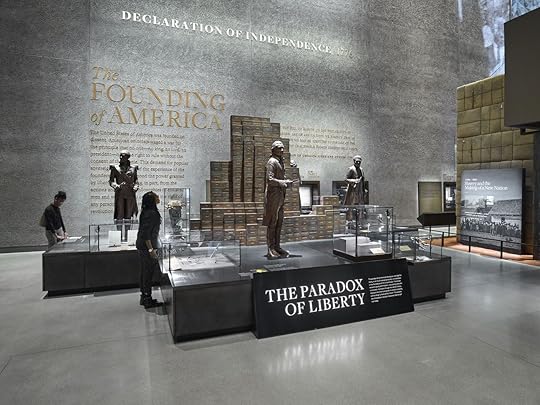
Photo: National Museum of African American History and Culture/AlanKarchmer
Inside, beeline for the history galleries located in Concourse C (C3, C2, and C1). These galleries spotlight the journey of 3.5 million West Africans who endured the brutal disregard of their humanity and the journey of their descendants. It begins with an elevator ride that functions as a well-curated illusion of time travel. From the bright, open space of the 21st century, visitors descend three levels below ground to the darkness and confinement of the 1400s.
C3 is up first, chronicling the transatlantic slave trade, the largest forced migration in history. At one point, the emergence of the high-ceilinged Paradox of Liberty hall appears to ease the tension that the gallery has cultivated, until visitors see a statue of Thomas Jefferson in front of a brick wall with the names of his 600 slaves that reminds them of slavery’s long, dark legacy in the United States.
Next is C2, which centers on racial segregation and Jim Crow laws in 1876-1968 America. This concourse emphasizes the dehumanizing effect of the “seperate but equal” doctrine and the role that the spoken word played in the modern civil rights movement, including a tribute to Dr. Martin Luther King Jr.
Lastly, C3 highlights the events of a changing America, beginning with the wave of Black movements and music of the 1960s and looking toward the future. The alley of three decades, from the 1980s to the 2000s, leads you toward the end of the history galleries, which amount to 60 percent of the museum.
12 must-see displays in the National Museum of African American History and Culture’s history galleries
Photo: National Museum of African American History and Culture
It would be unfair to rank one exhibit as more important than another since each is a piece of the puzzle that constitutes America. If you have only a few hours at your disposal, though, the following exhibits are a must-see for every visitor who wishes to connect the dots of history, note the remarkable progress, and aspire to go further forward.
1. Set of shackles (C3)These heavily rusted iron loops joined together by an iron rod have been recovered among many artifacts from the São José shipwreck off the coast of Cape Town.
2. The wall of the domestic slave trade (C3)As a result of the expansion of cotton cultivation, about “one million people were taken away from their families to vast plantations along the Mississippi River Valley.” Read their testimonies on the wall.
3. Stone slave auction block (C3)Get a glimpse at this large gray carved marble with a flattened top and bottom, used in Hagerstown, Maryland, during 1830.
4. Silk lace and linen shawl given to Harriet Tubman by Queen Victoria (C3)Harriet Tubman escaped slavery as a young woman in the early 1800s but returned to the South again and again to lead other African Americans to freedom.
5. Violin played by the enslaved man Jesse Burke (C3)The violin belonged to Elijah Burke, owner of the Mount Pleasant Plantation in Phillips County, Arkansas. Before he died in 1860, he gave the violin to one of his enslaved men, Mr. Jesse Burke, who used to entertain the slaveholder and his guests.
6. Cabin from the Point of Pines Plantation in South Carolina (C3)
Photo: National Museum of African American History and Culture/EricLong
After emancipation, many African Americans returned to the plantations to find work and moved into the same cabins they occupied during slavery.
7. Interactive lunch counter (C2)Inspired by college students’ bravery at a segregated Woolworth’s department store eatery, the lunch counter is an installation of interactive touch screens facing a panoramic news footage projection of the fights for equality. Sit on any of the counter stools and explore the menu of movements, from sit-ins to bus boycotts. This intriguing experience puts you in the shoes of freedom fighters. Even if you have to line up for one of the 12 stations, it’s definitely worth your time.
8. Segregated railroad car (C2)This is one of the largest and most iconic exhibits demonstrating the brutal impacts of segregation under the Jim Crow era. Enter the car to witness the challenges African Americans faced during their travels around the country.
9. Angola Prison Tower (C2)Sitting on a raised platform is a life-sized steel and concrete tower from one of America’s most brutal prisons.
10. Emmett Till Memorial (C2)The casket of 14-year-old Emmett Till, who was murdered while visiting family in Mississippi in 1955 after whistling at a white woman is “one of our most sacred objects,” said Kinshasha Holman Conwill, the museum’s deputy director. The casket is placed on a pedestal in a separate room, and there’s a bench for those who wish to engage deeply with the significance of the exhibit. The young boy’s murder became a rallying point for the Civil Rights Movement.
11. The Oprah Winfrey Show exhibit (C1)Oprah Winfrey is the first African American to host a national show, which aired for 25 years. This exhibit is a reproduction of the setting with original furniture and objects.
12. Dress designed by Tracy Reese and worn by Michelle Obama (C1)Here the tour of the history galleries ends with the election of America’s first Black president. In the foreground of the many magazine covers and other memorabilia from the political campaign is the signature sleeveless black dress with red poppies that the First Lady wore in 2013 on the 50th Anniversary of the March on Washington.
The gallery you shouldn’t skip at the National Museum of African American History and Culture
Photo: National Museum of African American History and Culture/AlanKarchmer
The history galleries may occupy the majority of its physical space, but after diving into the past, you’d be remiss to skip the L galleries, which focus on African American community (L3) and culture (L4).
In comparison to the history galleries, the L galleries are bright, airy, and spacious. From the heritage hall, take the escalators to community galleries. In the “Making a Way Out of No Way” exhibits, you’ll see how African Americans have resisted and persisted, thanks to mutual support and through education, religion, entrepreneurship, and activism. Personal success stories are spotlighted here in spite of obstacles and lack of opportunity. Stories include those of Dr. Mary McLeod Bethune, who founded the National Council of Negro Women in 1935, and photojournalist Charles Harris, whose work now sits in the Carnegie Museum of Art. One room is dedicated to boxer and activist Muhammad Ali whose “stand for his personal, political, and religious convictions changed American history,” as the display reads.

Photo: National Museum of African American History and Culture/AlanKarchmer
The chronological exploration of African American activism that began in the concourse exhibitions continues here through participation in sports with memorabilia — such as Michael Jordan’s jersey, Joe Louis’s boxing gloves, and Gabby Douglas’s bar grips — and the statues of Venus and Serena Williams. Besides manifesting their physical ability and talent, many athletes used the fields, courts, and rings as a platform for social and political justice and equality.
In the Power of Place room, an interactive multimedia table features personal stories on identity. Migration, displacement, and travel are matters that touch communities globally, and this is a great opportunity to reflect on those. If you are running out of time, but you feel inspired, you can submit your story and images online. If you have time and want to pay respects to the African American soldiers who served in the military from the American Revolution to the War on Terror, visit the Double Victory exhibition on L3.
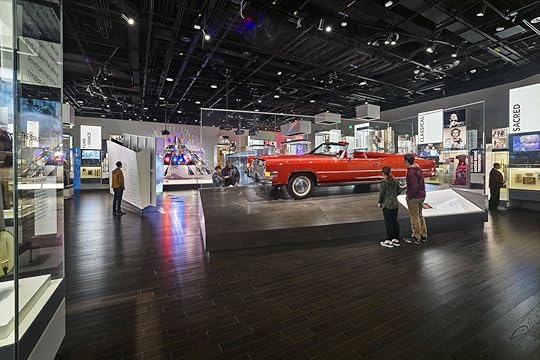
Photo: National Museum of African American History and Culture/AlanKarchmer
Next, L4 welcomes you with an impressive multimedia installation named “Cultural Expressions,” which focuses on style, cuisine, creativity, language, and dance. The musical crossroads hall — where you can see Sammy Davis Jr.’s tap shoes, Jimi Hendrix’s vest, and Chuck Berry’s red Cadillac — takes you through multiple genres of African American music. The speakers are on blast, and it’s very likely to see visitors moving to the beats of Chuck Berry, 2Pac, or Whitney Houston. You have just joined a party celebrating one of America’s most important cultural exports: music. Visual arts enthusiasts should leave themselves time to visit the dedicated gallery on L4. Paintings, sculptures, and drawings show how artists interpreted the history of their nation from the beginning of the 19th century to contemporary times.
The most underrated exhibitions to check out at the National Museum of African American History and Culture
Photo: National Museum of African American History and Culture/AlanKarchmer
If you’ve walked through all of the history galleries, you’ve covered more than a mile and centuries of history. As you make your way through, you may notice that the concourse galleries are cramped, and the only seating areas are in the designated “reflections” spaces. This is what makes the Contemplative Court by the exit to the history galleries such a thoughtful addition to Concourse C.
The Contemplative Court is a calm, reflective space and virtual transition from the dark past to the future. The soothing effect of the water that falls powerfully and uninterruptedly from a skylit oculus on the ceiling in the center of the room brings the catharsis you have been looking for after acknowledging your role in history. But at the end of the day, it’s a shared history. A quote by Dr. Martin Luther King Jr. on the wall across reads, “We are determined to work and fight until justice rains down like water and righteousness like a mighty stream.”
The L galleries also have a bonus gallery that should not be overlooked. Visit L2 to explore interactively more stories, images, and objects from the museum’s vast collection. This open space will capture the attention of all ages and is appealing to younger kids.
Before you leave the National Museum of African American History and CultureWhile food and drink are prohibited in the galleries, make time for lunch or a snack at the Sweet Home Café opposite the Contemplative Court. You may also want to leave time at the end of your visit to peruse the African American literature in the museum store. (While the store stays open until 5:30 PM, the last entrance is at 5:00 PM.) 
A version of this article was previously published on January 17, 2020, and was updated on March 23, 2022.
More like thisBlack TravelWhy Martinique Lewis Reimagined the Green Book for the Modern Black TravelerThe 8 Best Neck Pillows for Falling Asleep on Any Trip, According To a Sleep Science Coach

We hope you love the products we recommend! Just so you know, Matador may collect a small commission from the links on this page if you decide to make a purchase. See our full Advertiser Disclosure here.
There are a few things that scream, “look at me, I’m a tourist who’s never left my zip code before”: The Hawaiian shirt and sunhat outfit, the selfie stick, the fanny pack — you get the point. You might think, as I once did, that a big, bulky neck pillow belongs on that list too. After all, it’s one extra thing to carry, looks a bit clumsy, and doesn’t really give you that much support anyway, right? Well, if those things are true, it’s only because you don’t have the right pillow.
Neck pillows are a great tool to help get to sleep while traveling. They also help maintain good posture. Neck pillows support your neck so your body doesn’t have to strain your muscles while trying to hold the weight of your head when you relax. Don’t just take it from me — neck pillows also come highly recommended by sleep experts.
For an expert take on finding the best neck pillow, we caught up with Logan Foley, a certified sleep science coach at the Sleep Foundation. Foley tests sleep products for a living (you can learn more about the Sleep Foundation’s methodology for testing here, and see the full list of where the Sleep Foundation landed on travel pillows here). She describes her job as someone who can’t replace a doctor, but can give strategies, tips, and schedules to help you sleep better.
We spoke with Foley to learn all about the ins and outs of how to catch some much-needed Z’s while traveling with the proper neck pillow (hint: stuffing a pillow case with clothes won’t cut it).
Skip right to the eight best neck pillows for travelersThis interview has been edited for length and clarity.
Matador Network: What’s the most important thing when looking for a neck pillow?Logan Foley: When looking at and evaluating travel pillows, the most important thing for me is support, meaning how well it holds the head up when sleeping upright. There are other factors we look at as well including materials, cost, and customer service.
How does one find the perfect neck pillow?Travel pillows come in many shapes and sizes, and it’s really not one size fits all. Some people prefer the convenience of a blow up or collapsible pillow for travel, although I’ve found those are not the most comfortable options. The best option is the one that works for you.
A good neck pillow will have ample support and won’t wear down over time. Travel pillows that are filled with small beads may feel comfortable at first, but I have found they collapse after a few uses.
What has being a sleep science coach taught you about how to sleep while traveling?Sleeping while traveling is always tough, and even being a sleep coach doesn’t mean I’m immune to the hardship of trying (and failing) to fall asleep in the middle seat. One trick I’ve learned: Always try to get a window seat if you can. Worst case scenario, you can lean against the vehicle’s side or put your pillow against it.
Things to bring:
A travel pillowAn eye maskSome kind of noise canceling device (headphones, earplugs, etc.)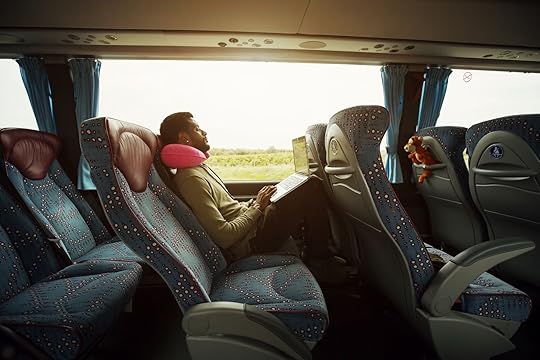
Photo: AnnaTamila/Shutterstock
Can you break down the main types of neck pillows, and what they’re best for?There are many types of travel pillows on the market.
The main ones are:
U-shaped: These are the typical travel pillows you will see in the airport shops. They are shaped like a U and fit around your neck to lay on your shoulders, providing good spine alignment. These are a good option for most sleepers, but can be difficult to pack due to their bulk.Wrap: Wrap pillows are relatively new on the market and may make you feel a bit odd on the first use. An example of a wrap pillow is the Ostrichpillow Go Neck Pillow, which is the main wrap pillow I have personally tested. It wraps around your neck, supporting your head much higher than a typically U-shaped travel pillow, which allows your head to tilt to one side. While your neck won’t be at a severe angle, having your neck titled for a long period of time may cause discomfort. This pillow is very packable and folds into a tight ball when not in use.Rectangular: Rectangular travel pillows look like the traditional pillows you use on your bed, but are typically lightweight and smaller. These will not support your head if you are sleeping upright, but are a good option if you’re looking for a pillow to use once you get to your destination.Which neck pillow do you most highly recommend?My top choice is the Cushion Lab Ergonomic Travel Neck Pillow. It has great neck support to promote spinal alignment, is made up of memory foam that won’t sag with use, and folds up tightly for easy storage.
What would you say to someone who insists they can just recline the airplane seat and sleep that way?I would say if you’re able to sleep comfortably in a reclined airplane seat, then you’re lucky! Again, these pillows are not a one size fits all product. If you have no trouble sleeping, you probably won’t be shopping for a travel pillow anyway. The one thing I would say is if you can sleep in a plane with no problem, but are waking up with neck pain, you may want to look into getting a pillow to protect your neck, especially if you’re traveling often.
The 8 best neck pillows, according to the Sleep FoundationAfter rigorous rounds of testing, here are the travel neck pillows that the Sleep Foundation recommends.
Best overall: Cushion Lab Ergonomic Travel Neck PillowBest value: Sleep Number U-Neck PillowMost comfortable: Bear Mini PillowBest for neck support: Ostrichpillow Go Neck PillowBest cooling: Sleep Artisan natural Latex Travel PillowBest for neck pain: PineTales Buckwheat Travel PillowBest for side sleepers: Pillow Cube ClassicBest for camping: Hest Pillow More like thisTITLE OF PIECE
More like thisTITLE OF PIECE
Map: The 8 Longest Direct Train Routes in the World

There are few methods of transportation like train travel. Trains have a limit on destinations and speed, but also allow for unparalleled window watching. Some can be an uncomfortable yet utilitarian way to get from point A to point B, while others are the epitome of luxury. For anyone who can get over the limitations, there’s no denying that the longest direct train journeys are high on the travel to-do list.
This map put together by Statista used data from The Telegraph to chart the longest direct rail routes where you don’t have to change trains.

Photo: Statista
The longest direct train routes in the worldMoscow to Vladivostok: 5,753 milesToronto to Vancouver: 2,775Shanghai to Lhasa: 2,717Sydney to Perth: 2,704Dibrugarh to Kanyakumari: 2,633Emeryville to Chicago: 2,438Paris to Moscow: 1,998Darwin to Adelaide: 1,851Of course, not all of these train routes are always accessible or safe to travel on for foreigners (especially during pandemics and wars). That doesn’t make the sheer magnitude of the rail line less impressive, however.
Note that these are only the longest direct train routes. If you really want to glue yourself to a train seat, the longest train route in the world takes advantage of multiple train lines as it goes over two continents and 11,653 miles from Singapore to Lagos, Portugal, in 21 days.
Some of these long train routes also double as one of the best ways to see the country they’re in. The Gahn, which goes from Darwin to Adelaide, gives incredible insight to hard-to-reach parts of Australia’s interior, for example. Others are among the train journeys that can take you to some of the most remote places in the world.
These also aren’t necessarily the best train rides. For that, you should listen to experts like the Man in Seat 61, who has made a living traveling the world by train. 
Your Next Family Trip Will Be a Breeze With These Packing Tips for Traveling With Kids

“Sure, having kids might make things more complicated, but I’ll still find a way to travel.”
It’s an optimistic refrain likely uttered by countless soon-to-be parents, but unfortunately, it’s easier said than done. Children change every aspect of your life, and that includes travel. Adding children to the equation doesn’t necessarily mean you have to forego vacations for the next 18 years, but you do have to change the way you travel – especially when it comes to packing.
Samantha Brown, a travel host known for her shows like Great Hotels, Passport to Europe, and her newest venture, Places to Love, knows first-hand how children change the travel equation. Prior to having twins Nine years ago, she traveled 230 days out of the year. That number is significantly lower now, but she still manages to make a living exploring the world – both solo and with kids in tow. To do so, she had to totally revamp her approach to packing. We talked to Brown to learn more about her inside packing tips for traveling with children.
Packing with kids requires thinking ahead
Photo: Halfpoint/Shutterstock
Adults can usually get away with putting little-to-no thought into their packing. Just haphazardly toss some shirts, pants, and underwear into a backpack, and you’re probably all set for a long weekend. Traveling with kids, however, is a whole different ball game.
“Where adults can wear the same pair of pants and tops a few times, kids can’t,” Brown says. “You have to pack outfits for every day and then have extra clothes with you in case of accidents.”
Traveling with young children in particular carries an additional set of challenges. As a parent of young kids, Brown says, you’ll probably “spend a lot of time on dirty floors and public restrooms. I took to wearing hiking pants with articulated knees and a high waist so that my underwear wasn’t exposed every time I bent over to pick the kids up. These pants could also be soaked and cleaned in a sink and hung overnight to dry.”
Space prioritization as a parent is also vastly different than the solo traveler. You’ll probably need to sacrifice some of your own comfort items, or favorite shirts, to make room for kid essentials. This also means you’ll need to bring more luggage than you might otherwise.
“Kids stuff always wins out,” she says. “We always bring two 31’ rolling cases when we travel with the kids and two carry-ons so it’s a lot more stuff – mainly clothes, since I won’t be able to get to a laundromat.”
Essential items to pack when traveling with childrenSo, what should parents add to their shopping list before traveling with children? According to Brown, it’s all about the luggage and the toys.
“I’m all for getting them their own little carry-on so they start to get used to carrying their own things,” she says. “For carry-ons I prefer soft-sided luggage. Hard case luggage is a real pain to get anything out of while in transit, there are no external pockets to quickly stash or store small items, and opening up a hard case requires twice the space because of its clam shell design.”
As for the essentials, like an on the go crib that can be set up at a hotel or other temporary residence, the good news is you probably won’t have to worry about packing those yourself.
“Most of the time,” Brown says, “hotels and cruise ships have cribs they can deliver to your room. We also have travel blow up beds that we still use and my kids are nine! They’re made by a company called The Shrunks.”
And because kids aren’t quite as entertained by museums, historic architecture, and airport people watching as we are, toys are a necessary diversion. Brown’s toy of choice for her kids? Balloons.
“I used to keep a handful of them to be inflated when my young ones needed to work off steam,” she says. “What’s great about balloons is it does not matter how hard you hit them, they won’t travel far or break anything, so they are a godsend when waiting in baggage claim or even in your hotel room. Bubbles are also great for babies. I’ve stopped many tantrums in public spaces by blowing bubbles.”
How travel changes with children
Photo: Tomsickova Tatyana/Shutterstock
Packing, of course, isn’t the only thing that changes when you travel with kids. Everything from the airport experience to the way you structure your travel days must be approached with more deliberate consideration.
While previously it might have been easier to simply bring a carry-on, traveling with kids means a trip to the baggage carousel is almost certainly a necessity.
“When my kids were young,” Brown says, “it was hard for us to carry luggage through a busy airport, push a stroller, and lug car seats, so I would check our bags just to be done with it.”
Her time in the destination itself looks different, too. Gone are the days of waking up at 7am, staying up until 2am, and cramming the day with hikes, bike rides, museums, and bars. Now, Brown and many parents need to be more selective about which activities they choose.
“I definitely do less, and enjoy more,” she says. “We only do one big thing a day, then have a break at a public park and playground or pool. We’re not out to win any awards for how much we did and saw, and just want to enjoy being together.”
While it might sound like traveling with children can deprive a once enthusiastic adventurer of many of the joys of travel, like in the independence and energy to check off every item on your bucket list, it can also help make your travel habits more efficient, and look at a destination through new eyes. As Brown says – it’s not about how much you do anymore, it’s about “being together.” 
We hope you love the travel products we recommend! Just so you know, Matador may collect a small commission from the links on this page if you decide to purchase anything. See our full Advertiser Disclosure here.
More like thisFamily TravelTravel Is the Best Gift You Can Give Your ChildWhat Actually Happens on an Orlando Ghost Tour, According To the Guy That Hosts Them

When it comes to ghost haunts, Orlando, Florida, is no stranger to the subject. Historical downtown Orlando is one of the city’s popular hotspots for paranormal activity and many Orlando ghost tours, and local ghost touring company American Ghost Adventures shows guests just that. American Ghost Adventures doesn’t just tour haunted attractions; they show their guests it’s more to it than what you see in Hollywood media.
The company not only teaches and educates guests about the paranormal world, but the tours also give insight into Orlando’s history and background and how it hasn’t always been the “happiest place on earth.” The Orlando ghost tours that they conduct give guests a different perspective of how the city is today from back then.
American Ghost Adventures gives guests spine-chilling but enticing and educational Orlando ghost tours along with some Orlando history. The company spoke with Matador about its ghostly hauntings and how its ghost tours respect the paranormal community and educate those about it.
We hope you love the Orlando ghost tour with American Ghost Adventures! Just so you know, Matador may collect a small commission from the links on this page if you decide to book a stay. Listed prices are accurate as of the time of publication. See our full Advertiser Disclosure here.
Want to know more about Orlando’s history along with taking an Orlando ghost tour? You can check out this Orlando ghost tour Airbnb experience.

Photo: Airbnb

Photo: Airbnb

Photo: Airbnb
We hope you love the Orlando Ghost Tours we recommend! Just so you know, Matador may collect a small commission from the links on this page if you decide to book a stay. Listed prices are accurate as of the time of publication. See our full Advertiser Disclosure here.
This interview has been edited for length and clarity.
Matador: How are these tours educating guests the correct way about the paranormal world?American Ghost Adventures: We tell our guests that we don’t taunt our spirits. They speak to us when they’re ready to or want to. We are visiting friends, and respect will be needed. Spirits were once people also, so they do have feelings. Relaying the proper history does matter!
How did this ghost tour experience come about?I’ve always had experiences and was frightened by them. There was a company in town, and they did investigations. I attended one and realized others had experienced the same things, and I wasn’t alone. I was able to invest in the company and became part owner. As the years went by, we had different visionaries for the company, and I created American Ghost Adventures in 2010.
What is your most popular ghost tour?The most popular tour for us is the 2 -hour downtown Orlando tour. This tour gives guests the best sample of everything—history, firsthand ghost stories, and a mini-investigation while on tour. Guests get to visit multiple buildings and use multiple different ghost detecting equipment.
Do you use any type of instruments/equipment on the tours?We are the only ghost tour in town that takes you INSIDE buildings and uses equipment. We have flashlights, dowsing rods, and K2 meters for use during our 2-hour tour. For our 4 hour ultimate tours, we have more equipment that we use because it’s a more extended tour.
What are your rules for your ghost tours?The number one rule is to RESPECT the living and the dead. Safety is huge because we are NOT recruiting for our ghost position. Come with an open mind and be prepared to have fun!
Are there certain things that guests are not supposed to do on ghost tours?Yes, don’t come on a ghost tour expecting to see a ghost! It’s called a ghost tour because we talk about history’s past. Don’t go on a ghost tour expecting to be scared! We are NOT a haunted house with pre-paid actors to jump out at you.
What is the craziest thing that has happened on a ghost tour?When we make contact with someone from the other side that is related to someone on our tour, it’s emotional and satisfying at the same time. We get to relay the message and bring closure for some people.
Is there a particular tour/place that gets the most energy when touring?Most of the locations we go to are because we’ve had amazing activity or interaction there. They are all hot spots and have their own crazy stories. Each guide has their favorite building and spirit that they have connected with.
Is there a crazy experience that the crew had while on tour?There was an incident where we witnessed/heard a spirit call my name across a spirit box. I don’t have a common name, so we knew they called my name. It was quite frightening and surprising. 
The best Mexico City Airbnbs
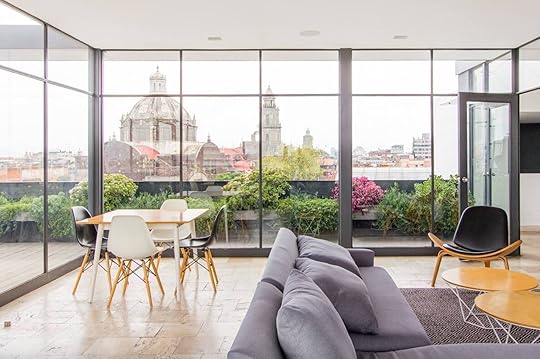
Mexico City was founded on top of the ancient Aztec capital of Tenochitlán, which existed from 1325 to 1521. Nowadays, the city is so large that it extends way beyond Centro Histórico, with many neighborhoods with totally different vibe. To help you choose an area, we’ve picked the best Mexico City Airbnbs in the most central areas of the city, and curated a list of interesting places to visit nearby. And, if you’re looking for the Mexico City adventure of your dreams without doing any of the organizing, Matador Network has the perfect trip waiting for you.
We hope you love the spaces and stays we recommend! Just so you know, Matador may collect a small commission from the links on this page if you decide to book a stay. Listed prices are accurate as of the time of publication. See our full Advertiser Disclosure here.
Best Airbnbs in Roma and CondesaSpacious, well-lit apartment in heart of Roma Norte
Photo: Airbnb

Photo: Airbnb

Photo: Airbnb

Photo: Airbnb
This bright and well-trimmed space has four very comfortable rooms that can receive up to 10 people. Casa Tierra is full of Mexican contemporary design pieces by M.A. and Cacao and is located on the busy Av. Álvaro Obregón, two blocks from Calle Colima. Here you will find several of the most interesting design stores in the city (look for your gifts inside the aptly named Happening Store), surrounded by many restaurants such as the classic MOG, Belmondo, the delicious tacos at Taquería Orinoco and the drinks of Páramo and El Parnita. If you are a vinyl lover, Revancha and La Roma Records are nearby.
Ten guests, four bedrooms
Price: $326 per night

Photo: Airbnb

Photo: Airbnb

Photo: Airbnb

Photo: Airbnb
This small but perfect loft, surrounded by greenery and opening onto the whole of Condesa from its living room, is ideal for one or two people. You can even open its windows to enjoy the sunrise and sunset from bed. With a spacious bathroom that includes a washing machine,it’s the ideal place for a long stay. It is very close to Avenida Alfonso Reyes and its delicious breakfast options, including Casa Bruna, Quesería de mí, and Peltre. You’ll have one of the best cafes in the neighborhood in Chiquitito and some good literature at El Péndulo Bookstore or the Fondo de Cultura Económica. You can get to Parque México easily and get to know the newest tortillería from the Mexican chef Enrique Olvera, Molino “El Pujol.”
Two guests, one bedroom
Price: $149 per night

Photo: Airbnb

Photo: Airbnb

Photo: Airbnb

Photo: Airbnb
This fully equipped apartment is ideal for those traveling with children, with high-speed internet and a supermarket next door. The well-known Don Juan Tacos is two doors away, famous for having appeared in the movie Amores Perros but around here, their notoriety is only tacos-related. Nearby you have the Parque España and there are a ton of gastronomic and shopping options.
Six guests, three bedrooms
Price: $191 per night

Photo: Airbnb

Photo: Airbnb

Photo: Airbnb

Photo: Airbnb
With a private terrace and enough space to feel at home, this loft with eclectic decoration can accommodate up to four people with all the comforts. Very close to a metro station and a few minutes’ walk from the Museo de Antropología and important galleries such as Kurimanzutto, you will be on the border of Condesa and the San Miguel Chapultepec neighborhood. This residential area is home to the best baguettes this side of the city at Deli Lou. It is also a good base camp to move within the city, or to get away from it all and stay at home working or resting.
Four guests, two bedrooms
Price: $238 per night

Photo: Airbnb

Photo: Airbnb

Photo: Airbnb
This beautiful space on Col. Cuauhtémoc is near Rokai, one of the best ramen spots in town. An impeccable place, this unit is fully equipped and comfortably fits four people. There is also an outdoor terrace (hammock included) perfect for yoga, training, or relaxing. You’ll be five blocks from the main avenue, Paseo de la Reforma, from which you can easily reach the Bosque de Chapultepec or any point in downtown CDMX. For a great breakfast, visit Niddo and in the afternoon, Salón Ríos is a classic cantina that serves Mexican antojitos followed by mezcal or tequila. If you feel like taking a walk within a 20-minute range you can visit the Museo e Antropología, the Museo de Arte Moderno, and the Tamayo Museum.
Four guests, two bedrooms
Price: $135 per night

Photo: Airbnb

Photo: Airbnb

Photo: Airbnb
Close to the popular Blom Café is this minimalist and well-lit studio apartment. A good example of the minimalist style common with Mexico City Airbnbs, this spot is perfect for those who travel alone or as a couple and who need a space to rest or a place from which to work, with the independence of having a kitchen and washing machine. In front of Roma Norte, this chic apartment is close to the historic center of Mexico City. You can have breakfast at Havre 77 or Café Nin, eat at Loose Blues or Masala & Maíz, indulge in a dessert at Joe Gelato, or enjoy a coffee or a cold beer at Cicatriz.
Three guests, studio
Price: $60 per night

Photo: Airbnb

Photo: Airbnb

Photo: Airbnb

Photo: Airbnb
This small but modern apartment is located in the heart of Centro Histórico (Downtown), within walking distance from the Cathedral, the Templo Mayor, the Plaza de Santo Domingo (including the famed street quesadillas on its corner), and the Palacio de Bellas Artes. You can’t miss eating at El Cardenal or Café de Tacuba, checking out the murals of the Palacio Nacional (you have to bring an original ID or they will not let you in), and walking the Alameda de Bellas Artes after visiting its Palacio until you reach Barrio Alameda. If you’re in the mood for live jazz, the Zinco Jazz Club — just up the road from the apartment — is your spot.
Four guests, one bedroom
Price: $68 per night

Photo: Airbnb

Photo: Airbnb

Photo: Airbnb

Photo: Airbnb
On the border with Roma Norte, this luxurious house is near what’s known as the Wanderlust District. With easy downtown access, there are many rooms for different capacities, perfect for groups of travelers seeking to maximize their budget. This house for sixteen people has three double bunk beds, includes breakfast, and has a shared roof garden where you can hang out or work. Next to it, you have metro and metro bus stations. The spot is within walking distance from Mercado Juárez, a true neighborhood market with its options of traditional food and local fruits, vegetables, cheeses, and meats. You can also walk to the Jardín Juárez to have a beer in the open air, go for a pizza at Dr. Pizza, and listen to live music at Parker & Lennox.
Sixteen guests, six bedroom
Price: $562 per night

Photo: Airbnb

Photo: Airbnb

Photo: Airbnb

Photo: Airbnb
This house with a private terrace and a shared garden was the first study of the famous muralist José Clemente Orozco. It is now managed by his granddaughters. He designed and built it between 1921 and 1923 with three bedrooms with private bathrooms. The house can comfortably welcome up to eight people. It is located in Coyoacán, one of the best neighborhoods to experience Mexico City beyond its central, tourist-heavy areas. If you choose it and you like art, don’t miss the Dolores Olmedo Museum, the Anahuacalli Museum, and the Diego and Frida House Studio Museum.
Eight guests, three bedrooms
Price: $165 per night

Photo: Airbnb

Photo: Airbnb

Photo: Airbnb

Photo: Airbnb
The upscale, business-centric area of Polanco is home to the Jumex and Soumaya Museum, the Inbursa Aquarium, many design shops, and the famous Pujol restaurant (book in advance). This apartment puts you close to it all, and it can accommodate up to seven people. With 24-hour security and on a very quiet street, you’re in a safe quarter in this apartment. You will be well connected to the rest of the city if you use private transport. Though, it’s just two blocks to the famous Presidente Masaryk street with some of the city’s luxury boutiques, a few blocks from the Parque Lincoln and a 25-minute walk from the Museo de Antropología.
Seven guests, two bedrooms
Price: $255 per night

Photo: Airbnb

Photo: Airbnb

Photo: Airbnb

Photo: Airbnb
Ideal for a group trip, this massive complex has five rooms in a building shaped like a snake. It is without a doubt the most unique of Mexico City’s Airbnbs and can accommodate up to six people. It was designed by the Mexican architect Javier Senosiain in 2008 and is a key example of the so-called organic architecture. It is on the outskirts of Mexico City, so plan to enjoy the nature of its gardens and stay in during your visit. Nearby is the Basilica de Los Remedios, one of the oldest in Latin America, with a traditional food market neaby. 
Six guests, five bedrooms
Price: $306 per night
Matador Network's Blog
- Matador Network's profile
- 6 followers



